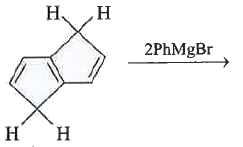Which of the folllowing ion will be aromatic in nature ?




The correct Answer is:A,C
To determine which of the following ions is aromatic in nature, we need to follow these steps:
Step 1: Understand Aromaticity
A compound is considered aromatic if it meets the following criteria:
1. It must be cyclic.
2. It must be planar (or nearly planar).
3. It must be fully conjugated (p-orbitals must overlap).
4. It must follow Huckel's rule, which states that the compound must have 4n+2 π electrons, where n is a non-negative integer.
Step 2: Identify the Ions
We need to examine the given options (though they are not listed here, we will consider common aromatic ions). The pyridinium ion is a common example of an aromatic ion.
Step 3: Analyze the Pyridinium Ion
- The pyridinium ion (C5H5N) is a six-membered ring containing five carbon atoms and one nitrogen atom.
- It is cyclic, planar, and fully conjugated.
- The nitrogen atom contributes one lone pair, but when it becomes a pyridinium ion (C5H5N+), it loses that lone pair and becomes positively charged.
- The remaining π electrons from the five carbon atoms contribute to a total of 6 π electrons, which fits Huckel's rule (4n+2 where n=1).
Step 4: Conclusion
Since the pyridinium ion meets all the criteria for aromaticity, it is indeed aromatic in nature. Therefore, the correct options that indicate aromatic ions are A and C, both being pyridinium ions.
Final Answer
The ions that are aromatic in nature are option A and option C (both pyridinium ions).
---
A compound is considered aromatic if it meets the following criteria:
1. It must be cyclic.
2. It must be planar (or nearly planar).
3. It must be fully conjugated (p-orbitals must overlap).
4. It must follow Huckel's rule, which states that the compound must have 4n+2 π electrons, where n is a non-negative integer.
We need to examine the given options (though they are not listed here, we will consider common aromatic ions). The pyridinium ion is a common example of an aromatic ion.
- The pyridinium ion (C5H5N) is a six-membered ring containing five carbon atoms and one nitrogen atom.
- It is cyclic, planar, and fully conjugated.
- The nitrogen atom contributes one lone pair, but when it becomes a pyridinium ion (C5H5N+), it loses that lone pair and becomes positively charged.
- The remaining π electrons from the five carbon atoms contribute to a total of 6 π electrons, which fits Huckel's rule (4n+2 where n=1).
Since the pyridinium ion meets all the criteria for aromaticity, it is indeed aromatic in nature. Therefore, the correct options that indicate aromatic ions are A and C, both being pyridinium ions.
The ions that are aromatic in nature are option A and option C (both pyridinium ions).
Topper's Solved these Questions
Similar Questions
Knowledge Check
Which of the following ions will be aromatic in nature?
A B
B C
C D
D
Which of the following reactions give aromatic ion ?
A B
B C
C D
D
Which of the following is anti− aromatic in nature ?
View SolutionWhich one of the following ion is aromatic ?
View SolutionWhich of the following in not aromatic in nature?
View SolutionMatch the folllowing:

View SolutionWhich of the following is anti-aromatic in nature?
View SolutionWhich of the following compound is Aromatic ?
View Solution
